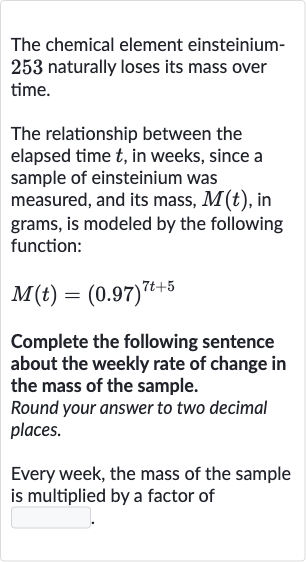AI tutor
Welcome to Bytelearn!
Let’s check out your problem:

The chemical element einsteinium naturally loses its mass over time.The relationship between the elapsed time , in weeks, since a sample of einsteinium was measured, and its mass, , in grams, is modeled by the following function:Complete the following sentence about the weekly rate of change in the mass of the sample.Round your answer to two decimal places.Every week, the mass of the sample is multiplied by a factor of
Full solution
Q. The chemical element einsteinium naturally loses its mass over time.The relationship between the elapsed time , in weeks, since a sample of einsteinium was measured, and its mass, , in grams, is modeled by the following function:Complete the following sentence about the weekly rate of change in the mass of the sample.Round your answer to two decimal places.Every week, the mass of the sample is multiplied by a factor of
- Function for Mass of Einsteinium: The given function for the mass of einsteinium is . To find the weekly rate of change, we need to determine the factor by which the mass changes each week. This means we need to evaluate the function for a one-week increase in time.
- Mass at Time and : Let's consider the mass at time , which is , and the mass one week later, which is at time , which is .
- Calculating the Weekly Rate of Change: To find the weekly rate of change, we need to divide the mass at time by the mass at time . This gives us the factor by which the mass changes each week.Rate of change =
- Simplifying the Expression: We can simplify the expression by using the properties of exponents. When we divide two expressions with the same base, we subtract the exponents.Rate of change = / = / = / =
- Calculating the Rate of Change: Now we calculate to find the weekly rate of change.Rate of change =
- Rounding the Answer: Round the answer to two decimal places to get the final weekly rate of change.
More problems from Compound interest: word problems
QuestionGet tutor help
QuestionGet tutor help
QuestionGet tutor help
QuestionGet tutor help
QuestionGet tutor help
QuestionGet tutor help
QuestionGet tutor help
QuestionGet tutor help
QuestionGet tutor help
